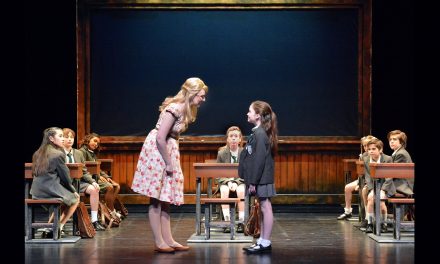After seeing Los Angeles Ballet’s The Nutcracker this past Thursday during a 2pm matinee at The Dolby Theatre, I am convinced it’s the only time of day to see the ballet. All the excited children sat anxiously in their seats, bows in, ties on, and buzzing with holiday fever. During the entire course of the production, the children would laugh at the Rat King, or verbally shout “behind you!” to Uncle Drosselmeyer in Act I, and I was suddenly reminded how inviting and magical this production is and continues to be each Christmas season. Besides its traditional staging value, it continues to be an interactive ballet, perhaps the only one that can reach the hearts and dreams of children and adults alike. LAB truly delivered a spectacular creation under its new Artistic Director Melissa Barak who noted in the program, “Los Angeles is a city brimming with talent, resources, and creativity. There is nothing that can stop Los Angeles Ballet from becoming a major dance force on the world stage.”
After seeing tiny little tweaks that elevated this enchanting ballet, I began to believe every word Barak wrote. Keeping with tradition, Act I, scene one with the arrival of the guests remained fairly traditional with Clara and Fritz eagerly anticipating the gifts of their Uncle, and the festivities of the Stahlbaum Family Christmas party. In Act I, scene two is where we see a slight reimagination of events, as Uncle Drosselmeyer, played by Eris Nezha, gives Clara a life size Nutcracker instead of a small toy version. Another variance is Fritz, played by Spencer Collins, who ends up being knocked over by the life size Nutcracker, when traditionally speaking Fritz would accidentally break the beloved toy version of the Nutcracker sending Clara into tears. Clara also had more challenging choreography, being played by company member Poppy Coleman, instead of a member of the youth ballet. From the audience’s perspective, she was believable as Clara, an adolescent girl with a hyper imagination and zest for big dreams and seemed to have been more loved by the adults than the children. Coleman, who played Clara slightly older, was able to tap into that beautiful moment in life when you are wanting more freedom and ready to break out. Still needing the comforts of home, Mr. and Mrs. Stahlbaum, played by Jacob Ray and Julianne Kinasiewicz, tuck Clara into bed before entering Act I, scene three when Clara dreams.
The dreamland production value did not disappoint, as Clara’s brass bed, with a lacy white quilt and bed skirt moved clear across the stage, and the already large Christmas tree, placed upstage, began to grow taller and taller and taller. These are the traditional elements of the ballet world that keep surprising you no matter how old you get. With physical props, and larger than life costumes, we enter the epic battle scene between the Mouse King, played by Ryo Araki, and The Nutcracker, played by Santiago Paniagua. In Nutcracker’s past, I have gotten through this scene without much attention or remembrance, but LAB made this incredibly memorable with its costuming and humor. The mice came out with enormous heads and tails, making the scene surreal and larger than life. The mouse king, and all his little followers, were high-spirited and theatrical with each movement. Not only dancing for the first few rows but being just outlandish enough that the back row of the theater would understand each emotion. Not to mention the children’s excitement with each lunge of the sword, and each march of the nutcracker. It’s the tale of good vs evil, of right vs wrong, that stands the test of time. The exceptional choreography, with all its hazards of heads and tails flinging about, was well executed and enjoyable to watch.
After the Mouse King is killed, and whisked away off stage, Clara and her Nutcracker are taken to the beautiful land of snow in a moving golden sleigh pushed by Uncle Drosselmeyer. The effect of snow falling from the rafters was the extra touch during the snowflake dance that made you feel like you’ve entered another world. And the Los Angeles Ballet, with set design by Catherine Kanner, continued this whimsy with dramatic icicle head pieces and long iridescent skirts that sparkled in the light. The dance of the snowflakes, a milestone casting for any aspiring ballerina, remains quite simple in its execution by challenging the body in its duration and longevity. The dance of the snowflakes mimicked the fall of snow, having moments of lull and coasting through the air, until a gust blows and swirls a snowflake into a frenzy of exciting leaps and bounds. It’s with this mimicry that we begin to understand the dreamland, and this is made more apparent by Los Angeles Ballet upon the introduction of Marie, played by Kate Inoue.
Each ballet across the world seems to have a different imagination of The Palace of the Dolls, and the Dolby Theater stage was transformed into a Palace by the Sea for the grand entrance of all of Clara’s dolls come to life. Marie, or traditionally known as The Sugar Plum Fairy, directly reflected Clara’s costuming in a simple off white gown with red satin details. Marie, likewise, wore an off white tutu with three large red satin bows down her torso. The simple decision of costuming, by Mikael Melbye, really honed in on the idea that Clara is dreaming by reflecting her costuming. In Act II, Scene One we are introduced to the Spanish, Arabian, Russian, Harlequin and Columbine, and the Sunflower dances. By far, the crowd pleaser of the evening was the Russian dancers, played by Cesar Ramirez Castellano, Ryo Araki, and Jacob Soltero. The three men defied gravity all together, while the audience broke out into a rhythmic clap of celebration! Feeling the power of community through dance, is perhaps the only true attribute of a ballet to begin with. And while we had a sense of awe with the Arabian dancers, and a sense of play with the Harlequin dancers, it’s that interactive choreography that breaks the wall between audience and dancer, between what is a dream and what is reality. In the dance of the Sunflowers, we were introduced by another show stopper, the Rose played by Petra Conti, who remains LAB’s only female principal artist. The Sunflowers and Rose were another showstopper in the Palace of the Dolls by engaging us with their stamina and ease rather than complicated footwork and quick staging. The long petaled skirts and bonnets were muted in earth colors and tones rather than the usual bright flashy costumes of the past. It all became so easy on the eyes, and incredibly calming and enjoyable to sit back, take it all in, and watch.
And as Act II, scene two opens with Clara on the floor, her parents come in to see that she’s fallen asleep. Upon lifting her back into her own bed, the drums desist, and Clara quickly sits up, eyes wide, mouth gaping, and we wonder if it was in fact a dream or real. The Nutcracker has continued to defy audiences since its premier in 1892, and has been revisited, reconceptualized, and remains relevant to the spirit of Christmas and the holidays today. Los Angeles Ballet was able to tweak and modify the original story in a playful and simple way that continued to delight and surprise. If this is anything like what we have to look forward to under Melissa Barak’s direction, then audiences are in for a real treat this 2023 season.
For more information about Los Angeles Ballet, please visit their website.
Written by Grace Courvoisier for LA Dance Chronicle.
Featured image: Los Angeles Ballet – Kate Inoue and Santiago Paniaqua in The Nutcracker – Photo by Reed Hutchinson










